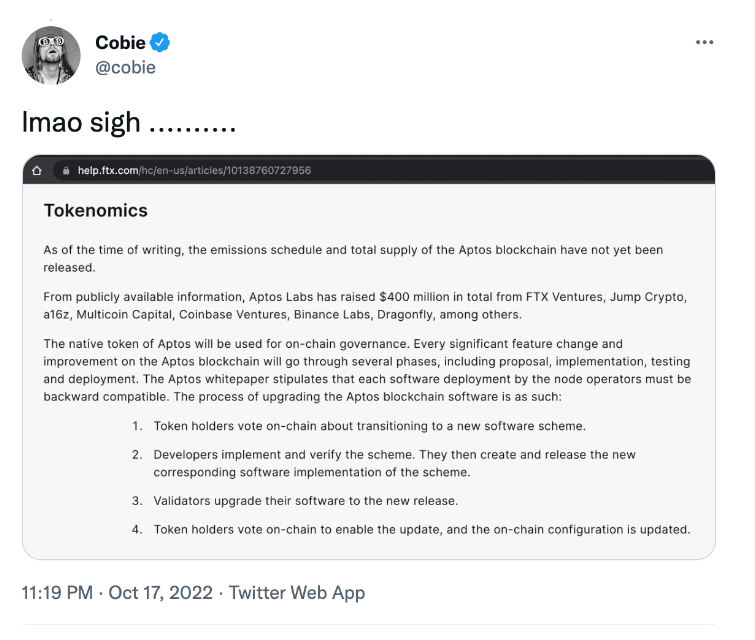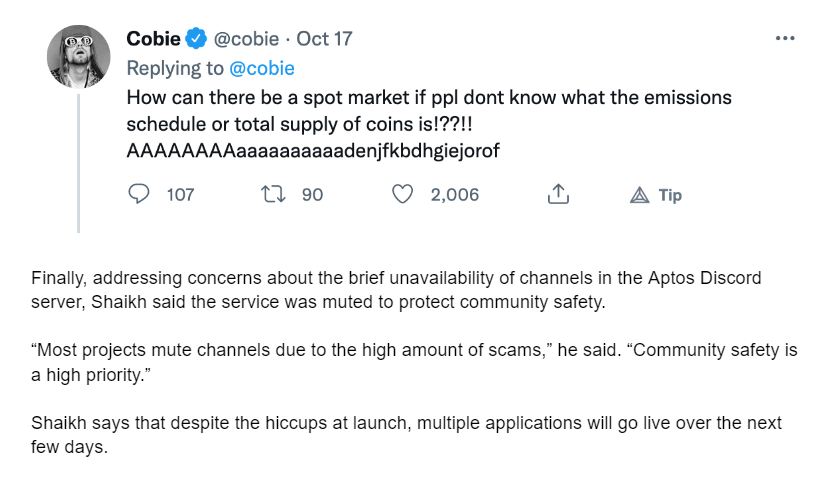Check out the biggest breaking crypto market updates for today:
Meta’s Defunct Aptos Blockchain Launches With Concerns Over Tokenomics
Aptos, a VC-backed, layer-1 solution born from the ashes of Meta’s defunct Diem project, launched its mainnet Tuesday.
However, post-launch the Aptos blockchain received criticism for its low TPS (Transactions Per Second) and tokenomics model.
Aptos had claimed a speed of 130,000 TPS prior to mainnet launch, which is vastly different from the speed of seven TPS it displayed post-launch – less than the Bitcoin blockchain. It also delayed revealing its tokenomics model until after the launch of its mainnet.
“The majority of these transactions are not actual transactions,” wrote aspiring “Twitter VC ghostwriter” @ParadigmEng420. “They are merely validators communicating and setting block checkpoints and writing metadata to the blockchain.”
In response to criticism, Aptos co-founder Mo Shaikh stated,
“The current TPS is not representative of the network capacity – this was the network idling ahead of projects coming online. This number is expected to increase with more activity. Hope this clears up any TPS confusion.”
Although after it first launched, he did acknowledge that it could have gone better.
Shaikh explained that the Aptos genesis occurred on October 12, 2022 with 102 validators to secure the network. “These validators have gone through extensive testing ahead of mainnet,” he said.
Shaikh then turned his attention to the issue of Aptos’ tokenomics, a facet that had drawn considerable questions and concerns following the launch. Shaikh said Aptos tokens are “designed with people at the core,” and published a chart listing the four categories of token distribution and what percentage and amount of initial tokens each would receive.
According to Shaikh, many of the tokens included those allocated to the community, with foundation categories staked at the time of the Aptos genesis. He explained that everyone who subsequently stakes would receive a pro-rata staking reward (~7% per year) that would unlock every 30 days.
Not everyone was impressed.
“Locked tokens are a meme if they’re used to farm and dump rewards,” tweeted crypto analyst @AkadoSang, Calling locking and staking tokens “a sneaky way to get liquidity since backers usually hold a great deal of supply.”
In addition to the mainnet launch, Binance FTX, and OKX said they are launching perpetual contracts using the Aptos APT token an hour after it started trading. Perpetual futures contracts allow traders to bet against the price of an asset.
Crypto podcaster Cobie was not impressed with the FTX and Binance listings news, asking how a spot market can operate if traders don’t know the emissions schedule or total supply of coins.


Celo Protocol Moola Market Loses Over $10M In Market Manipulation Attack
Celo network-based DeFii lending protocol Moola Market has reportedly suffered a market manipulation attack that saw the protocol lose over $10 million dollars in tokens.
The attacker manipulated the price of Moola’s native MOO token by initially purchasing around $45,000 worth of MOO and depositing it as collateral to borrow Celo. He then used the Celo tokens to borrow more MOO.
He repeated this cycle many times to inflate the price of MOO by 6,400%.
After the exploit, Moola Markets paused operations and launched an investigation into the exploit. It had also contacted authorities and offered a bug bounty to the exploiter if funds were returned within 24 hours. Shortly after, the attacker reportedly returned over 93% of the funds exploited and retained around $500,000 as a bug bounty.
Moola developers said the attack started during late Aisan hours on Tuesday. “An unknown attacker started manipulating the price of MOO on Ubeswap, allowing the attacker to manipulate the MOO TWAP price oracle used by the Moola protocol,” they wrote.
Oracles are third-party services that fetch data from outside a blockchain to within it.
The attacker borrowed a large amount of cUSD and cEUR, two Celo-based stablecoins pegged to the US dollar and Euro respectively, and CELO from the protocol using MOO as collateral, effectively draining the protocol of its funds. Trading on the platform awas stopped at that time.
Developers said they contacted law enforcement shortly after discovering the issuer. A while later, an individual identifying as the attacker reached out to the team confirming their involvement. This individual heldt he private key to the stolen funds.
Moola said it was then able to negotiate with the attacker. At the time of writing, Moola recovered over 93% of the stolen funds some 12 hours after the incident.
Meanwhile, a governance proposal has been floated by the community to prevent further similar attacks. The protocol seeks to lower the liquidation levels that govern MOO’s use as collateral on the platform – effectively “removing it as a viable collateral asset.”
The attack is the latest in a long list of exploits this month. With October already becoming the worst month ever for crypto attacks.
Decentralized Social Media Project BlueSky Unveils Latest Protocol
According to a tweet from BlueSky, the decentralized social media project is renaming its previously announced “ADX” protocol to the “authenticated Transport Protocol” or AT Protocol for short.
It also provided additional documentation on the scope of the project.
The AT protocol will reportedly run on a federated network and is described as a “protocol for large-scale distributed social applications” that will allow for account portability, algorithmic choice, interoperability and performance.
To explain the network model, Bluesky offered an example where many sites run the protocol, and users may choose among providers.
BlueSky explains the federated network as a network in which many sites run the protocol, and users may choose among providers. This provides individuals or businesses with the option to self-host.
So far, the project has an official website that remains under construction, and the company teased the release of an upcoming socially-focused Bluesky App, built on the AT protocol, for which users may join the waitlist.
In terms of online identity management, in an effort to provide greater control to users, AT Protocol will enable account swaps between providers that Bluesky said will not incur any data loss or impact social graphs.
Bluesky’s approach to account management “doesn’t require ties to real-world identity,” Dorsey tweeted a response to another user in his own thread on the announcement, adding that to do so would be “very wrong.”
Closed source algorithms that select what users can see and who they can connect with can become problematic in cases where misinformation or divisive messages become overly prevalent. Bluesky will support open-source algorithms that, it said, will put a greater degree of control back into the hands of users in terms of content and connectivity.
In August 2021 Bluesky hired Jay Graber, a former Zcash and Skuchain software engineer and founder of the social event startup Happening Inc., to drive development for the decentralized social media protocol.
- Best Gold IRA investment strategies - July 24, 2024
- Gold IRA Rollover: How to Convert Your Retirement Savings - July 24, 2024
- Understanding Gold IRA: A Comprehensive Guide to Secure Retirement - July 23, 2024
